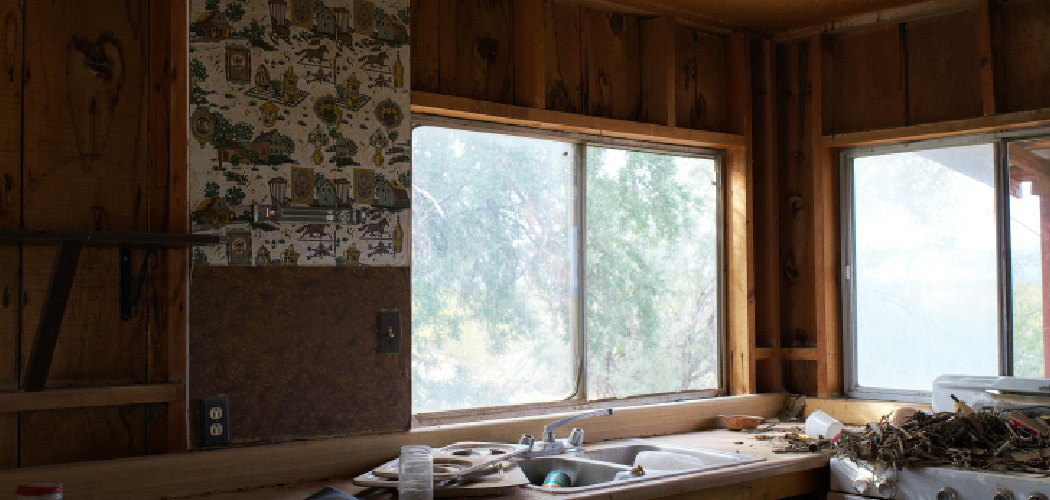Rust stains on kitchen counters can be a frustrating eyesore, especially when you strive to maintain a spotless kitchen environment. These stains are usually caused by the oxidation of metal items that come into prolonged contact with moisture, creating unsightly reddish-brown spots.
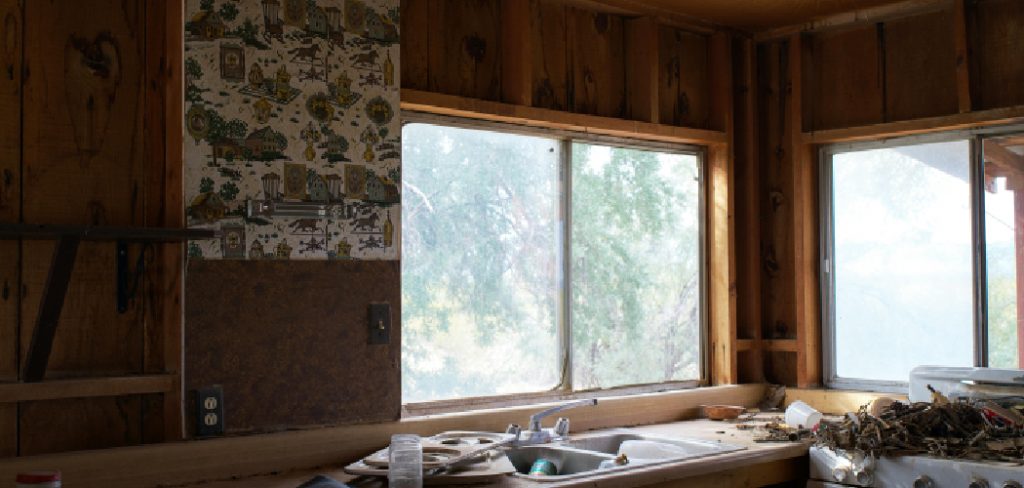
Fortunately, several effective methods exist to remove rust and restore your countertop’s pristine appearance without causing damage. In this guide on how to get rust off kitchen counter, we’ll explore some easy and household-friendly techniques to tackle those stubborn rust stains, ensuring your kitchen counter remains as good as new.
Whether your counter is made of granite, laminate, or stainless steel, these cleaning solutions will help you preserve its surface and extend its longevity. Let’s dive in!
What Will You Need?
You’ll need a few basic supplies available in most households to remove rust from your kitchen counter. These include:
- Baking soda
- White vinegar
- Lemon juice
- Salt
- A soft cloth or sponge
- A toothbrush
If the rust stain is particularly stubborn, you may also need a commercial rust remover or fine-grit sandpaper.
10 Easy Steps on How to Get Rust Off Kitchen Counter
Step 1. Identify the Rust Spot:
Begin by carefully examining your kitchen counter to locate rust spots. These spots often appear as reddish-brown discolorations and can vary in size and intensity depending on the extent of rusting. Identifying the exact location of these rusted areas is essential to apply the cleaning solution effectively without unnecessarily scrubbing other counterparts. Observing the rust spot from different angles may help in revealing any faint spots that are often overlooked. Once identified, ensure that the area is free from debris or loose dust particles by gently wiping it with a dry cloth, setting the stage for an efficient cleaning process.
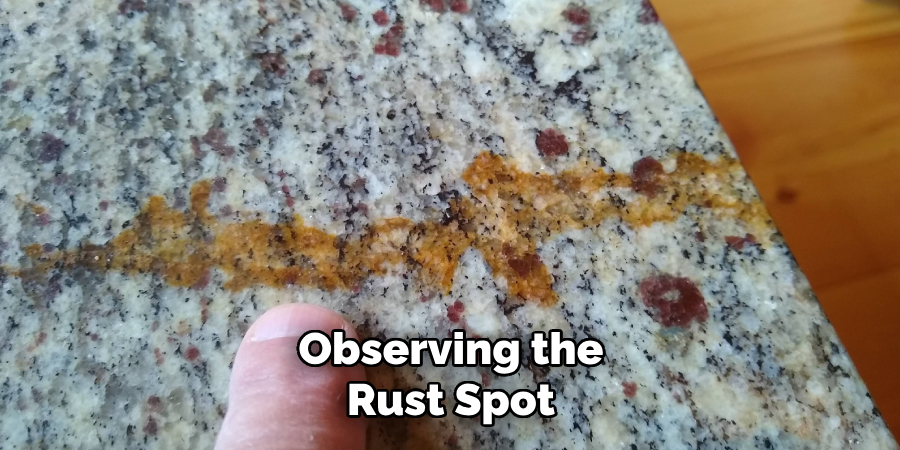
Step 2. Prepare a Cleaning Paste:
Mix a few teaspoons of baking soda with enough lemon juice in a small bowl to form a thick, consistent paste. The combination of baking soda and lemon juice is a natural and effective rust remover because the mild abrasiveness of baking soda helps to scrub away the rust while the acidity of the lemon juice dissolves it. Stir the mixture until it reaches a smooth paste-like consistency. In the next step, this paste will be applied directly to the rust-affected area.
Step 3. Apply the Cleaning Paste:
Using a soft cloth or sponge, gently apply the baking soda and lemon juice paste directly onto the rust stain. Ensure the entire rust-affected area is adequately covered with the paste. Applying a generous amount without spreading it to unaffected areas of your countertop is crucial, as it helps concentrate the cleaning action on the rust spot. Allow the paste to sit on the stain for at least 15-20 minutes. This waiting period gives the paste enough time to break down and dissolve the rust, making it easier to remove in subsequent steps.
Step 4. Gently Scrub the Area:
After allowing the paste to sit, take a toothbrush with soft bristles and gently scrub the area where you applied the paste. The objective is to loosen the rust particles without scratching the countertop surface. Use circular motions to agitate the paste, focusing on breaking up the rust without applying too much pressure, which could damage the surface. If the rust is particularly stubborn, you should reapply the paste and let it sit for a little longer before scrubbing again.
The paste may sometimes dry out slightly, making it more effective at absorbing the rust particles. After cleansing, wipe away the loosened rust and leftover paste with a damp cloth, checking to see if traces of rust remain. If needed, repeat the process for any persistent spots.
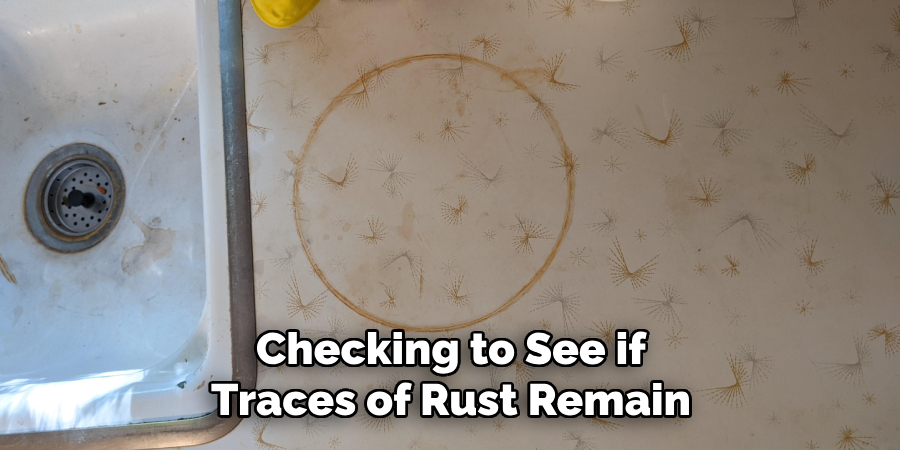
Step 5. Rinse and Dry the Area:
Once you have scrubbed the rust stain effectively, it’s time to rinse the area thoroughly. Use a clean, damp cloth to remove any remaining paste and rust residue. Removing all cleaning agents to prevent any reaction with other substances later on is essential. After rinsing, use a dry cloth or paper towel to pat the area dry thoroughly, as excess moisture can lead to further rusting. Ensure there is no wetness left on the counter, as humidity can facilitate the recurrence of rust over time. Proper rinsing and drying leave your counter clean and clear of rust and help preserve its material and finish.
Step 6. Treat Stubborn Stains with Vinegar:
If some rust remains after following the previous steps, it’s time to bring in the cleaning power of white vinegar. Pour a small amount of white vinegar onto a soft cloth, then dab and press it onto the stubborn rust spots. Vinegar’s acetic acid works to dissolve rust efficiently, breaking down the bond between the rust and the countertop surface. Allow the vinegar to soak in the rusty areas for about 10 minutes.
Avoid pouring vinegar directly onto the counter to prevent it from affecting areas unaffected by rust. After the soaking period, gently scrub the spots again using a toothbrush, and then wipe the area clean with a damp cloth. Dry the surface thoroughly to prevent new rust from forming. If the stains persist, repeat this step until the rust is no longer visible.
Step 7. Use Salt and Lemon Juice for Tough Rust
For extremely tough rust stains that resist other methods, a combination of salt and lemon juice can be particularly effective. Start by generously sprinkling salt over the affected area. Next, cut a lemon in half and squeeze its juice over the salt-covered rust. The acid in the lemon juice, combined with the abrasiveness of the salt, creates a potent natural rust remover. Let this mixture sit on the rust for several hours, preferably overnight, to allow it to break down the rust thoroughly.
After the soaking period, use a toothbrush to scrub the area, applying gentle yet firm pressure to lift the rust. Rinse the area with a damp cloth and thoroughly dry it to prevent any future rust formation. If needed, repeat the process for any lingering rust spots.
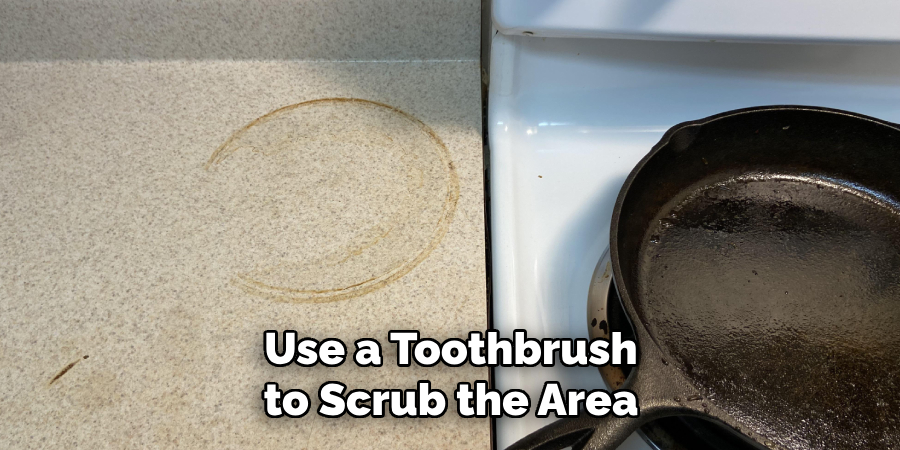
Step 8. Prevent Future Rust Formation
Implement preventative measures to safeguard your kitchen counter from future rust spots. Begin by placing coasters or mats under metal appliances and containers that could potentially rust and stain the surface. Regularly wipe down the countertop to keep it dry, as excess moisture contributes to rust development. Additionally, consider applying a suitable protective sealant designed for your countertop material; this acts as a barrier against moisture and spills.
Step 9. Regular Maintenance and Inspection
Consistent maintenance and regular inspection are vital in keeping rust at bay and prolonging the life of your kitchen counter. Regularly inspect the counter weekly for any signs of rust or moisture collection, especially in areas frequently exposed to water or metal objects. Promptly address any minor rust spots by using the cleaning techniques outlined earlier to prevent them from worsening. In addition, maintaining a routine cleaning schedule using non-abrasive cleaners will help keep your countertop in pristine condition, ensuring it remains rust-free and visually appealing for years to come.
Step 10. Professional Assessment and Care
If rust issues persist despite following all the outlined steps, it may be time to seek professional assessment and care. Contact a specialist who can evaluate the condition of your countertop and recommend commercial-grade solutions or procedures to remove rust effectively. Professionals often have access to advanced tools and products to address deeper or more stubborn rust issues without damaging the surface. This step ensures that your countertop receives the appropriate treatment necessary to restore its appearance and functionality.
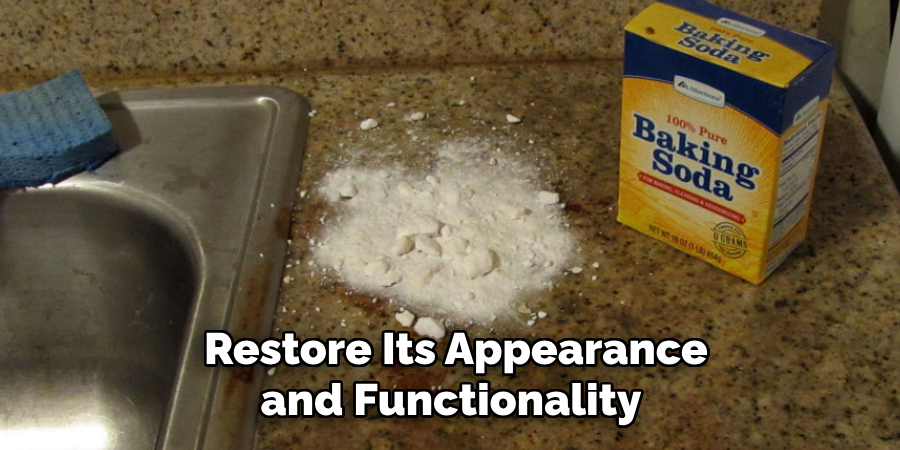
By following these ten steps, you can effectively remove rust from your kitchen countertop and prevent it from recurring.
5 Things You Should Avoid
- Using Abrasive Materials: Scrubbing with steel wool or harsh scouring pads can scratch and damage the surface of your kitchen counter, making it more susceptible to future rust and stains.
- Ignoring Protective Measures: Failing to protect surrounding areas with tape or covering while treating rust can result in damage or stains to other parts of your counter or kitchen appliances.
- Neglecting to Test Cleaning Solutions: Applying chemical cleaners or solutions directly without testing on a small, inconspicuous area first may lead to discoloration or damage, especially on sensitive surfaces.
- Leaving Solutions Unattended: Allowing cleaning solutions to sit for too long can cause unintended damage to the countertop material, potentially leading to more significant issues like erosion or staining.
- Using Excessive Moisture: Over-saturating the area with water or cleaning agents during the rust removal process can penetrate seams and cause underlying damage, leading to further rust and deterioration.
Conclusion
In conclusion, how to get rust off kitchen counter involves a combination of effective cleaning strategies and preventative measures tailored to preserve the integrity of your countertop.
You can efficiently eliminate rust and stains by carefully following the steps of rinsing, thoroughly drying, and applying natural remedies like vinegar and lemon juice. Additionally, preventative practices such as using coasters, applying protective sealants, and maintaining a regular cleaning routine are vital in preventing future rust formation. Regular inspection and prompt attention to minor issues ensure your kitchen counter remains in excellent condition. In cases where rust persists, seeking professional help can provide solutions beyond home remedies.
By aligning diligent efforts with these guidelines, maintaining a rust-free and visually appealing kitchen counter is both achievable and sustainable.
